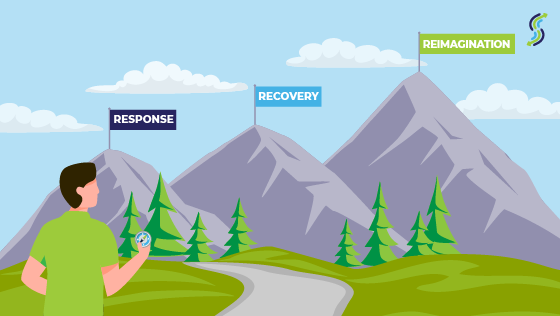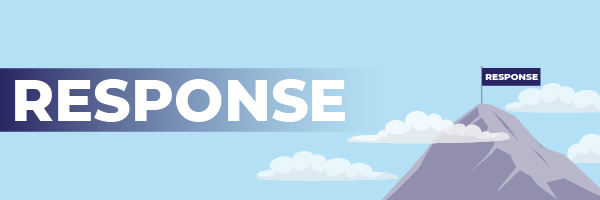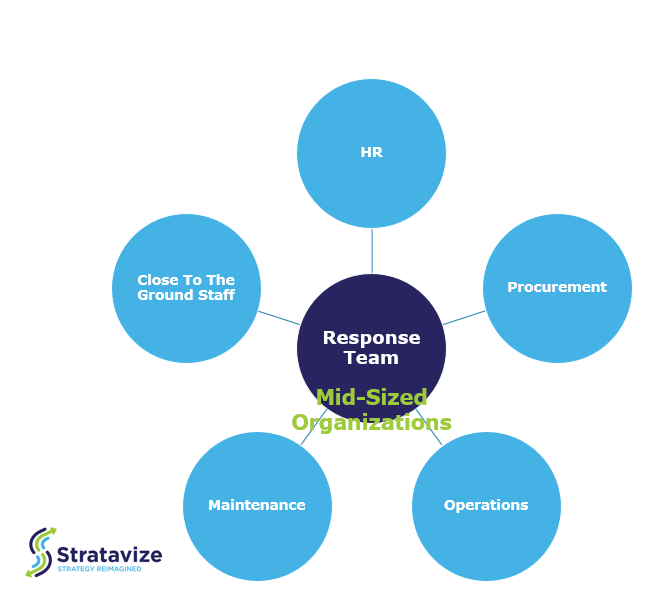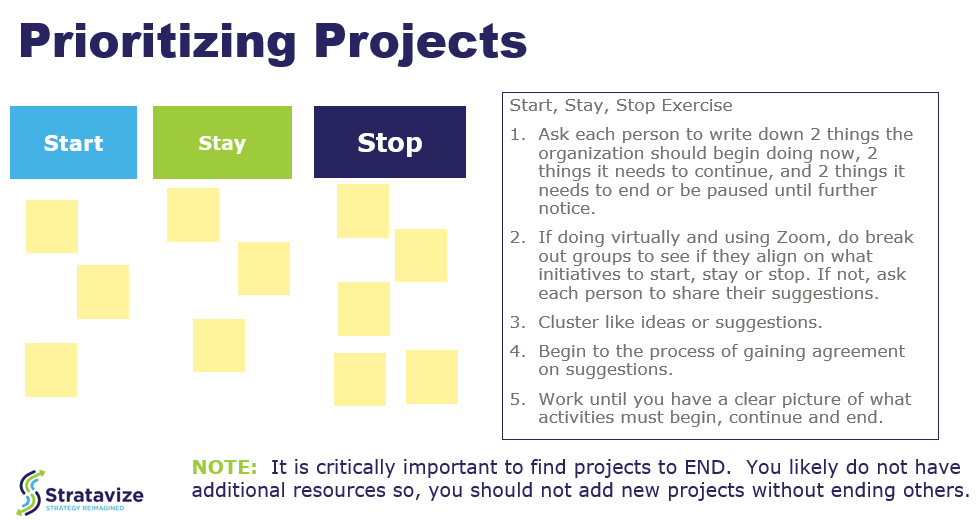We’ve created a 3-part article series for you and your leadership team to survive in the interim, endure the next 3 to 12 months, and achieve growth in the long term. We are sharing how we are serving our clients with a 3- phase business continuity plan. Phase 1: Response, phase 2: Recovery, phase 3: Reimagination.
Huge global corporations have almost unlimited resources and extensive experience in crisis management. This 3-part series is for mid-sized to large organizations with fewer resources and less experience. Here, at Stratavize Consulting, we’ve taken what works for the world’s largest corporations and modified it for mid-sized to large organizations. We’ve worked on both sides of the business world, huge corporations to the smallest of organizations. We are providing the framework we are using now to guide our clients through this crisis using tactics that work.
Part 1: Response
Most of us are on the other side of the Coronavirus shock. Weeks ago organizations were scrambling to comply with State and Federal guidelines of shutting down non-essential consumer-facing organizations. Non-essential business leaders made quick decisions to move completely remote, furlough employees, or close the business.
Those essential organizations, leaders had to quickly ramp up and prepare their employees for the front lines. For example, tasking the technology teams to expand the pool of employees working remotely, closing customer-facing branches, offering drive-up only options, or creating interim measures to protect employees while they continue to produce goods or services. In addition, to changing policies, some companies began to produce new products or services.
Many organizations have not adequately responded, exposing them to risk.
Smithfield, one of the country’s largest pork food producers, did not adequately respond to this crisis. Resulting in the Sioux Falls, South Dakota facility becoming a hot spot. Smithfield is now grappling with 783 employee cases and how to improve their facility overnight. By not responding swiftly and with employee protection in mind first, Smithfield is now faced with closing the facility and PR nightmare.
Washington Post reported earlier this month there are thousands of OSHA complaints being filed due to unsanitary, unsafe, and non-coronavirus compliant working conditions. Factories are not sanitizing between shifts, fast food workers are not wearing gloves, and call centers are not social distancing. The risk is high for not properly responding to this outbreak.
Increasing Your Response To Covid-19 Through Business Continuity Plan
We are not out of the woods by a long shot with the virus. Though some states are opening now or in the next few weeks, the threat of the virus being spread is still out there. If your organization’s not adequately responded, let us get you started with the first phase of the business continuity plan. This first phase strengthens the response to protecting employees, and customers while reducing liability.
Strengthen Your Organization’s Response
Step 1: Create A Response Team
We are supporting our clients by acting as Response Team (RT) advisory consultants or project managers, working as an extension of their RT. Our role is to help our clients accelerate the work and reduce risk. However, if you have the capacity and resources internally create the Response Team, then use this 3-part series as a framework for completing the work.
Start with an internal team that’s only focused on creating policies and procedures to protect employees and customers while reducing business liability. Depending on the size of your organization this team may include HR, Procurement, Facility Management, and Operations. We recommend the team include someone close to the day-to-day operations. This team will act as a project team and advisory group. Lastly, they will set the tone of the Covid-19 response within the organization.
Step 2: Safety First
Task the Response Team with evaluating internal configurations of the facilities. During the internal examination, the team will evaluate all spaces, employees, customers, or vendors visit.
Sample List of Evaluation Questions:
- What’s working right now with our initial response?
- What’s not working?
- Where do customers/clients/patients stand near employees?
- How is the interaction between employees and customers taking place today?
- Where do clients/customers/patients wait prior to being served?
- How close are employees working next to each other?
- How many open work stations/spaces/offices do we have available?
- What do employees or customers touch? (clock in-machines, door handles, equipment, break rooms, etc.)
- How many workspaces can be further separated?
- What equipment, tools, or other items are shared among employees?
- Where are packages shipped and received, are there one or multiple locations?
- Are there vulnerabilities in accessing the building and/or parking?
- What equipment and/or tools leave the building to service customers/clients? How do they arrive back in the building?
Step 3: Safety First Action Plan:
Using the data collected from the facilities evaluation the Response Team can make safety recommendations to the C-Suite. The Safety First Action and Risk Reduction Plan should include:
- redesign of facilities to meet social distancing requirements for customers, employees, and vendors
- clearly identify potential places where social distancing may be difficult to achieve along with a mitigation plan
- how the facility will engage with local and state leaders; like the Health Department or political leaders
- outline of policies and procedures that will need to be updated to reflect new recommendations
- communication (internal and external) and activation plans
- equipment recommendations and how the equipment will be accessed and disposed of (masks, gloves, shields, dividers, hand sanitizing stations, new washing stations, etc.)
- proactive measure recommendations (taking temperatures as entering the facility, etc.)
- complying with HIPPA and protecting other employees when someone is Covid-19 positive
- specific travel restrictions or changes in policy beyond the immediate shutdown
- feedback loop from employees to management; an open line of communication of what is working with new protocols and what is not working
Recommendations should answer:
- What items can be removed? (keeping specific doors open to reduce touches, waiting room furniture, etc.)
- What is our policy for bringing things into the facility?
- What will be our coronavirus testing protocols?
- Where will we source employee protection equipment?
- How and when we will communicate to employees and customers these changes?
- What materials will be needed to support communications and education?
- Where will employees and customers go for more information about our changes?
- What policies will address employee noncompliance?
Step 4: Implementation Plan For Safety First
To go from concept to completion takes an action plan and people. In other words, the organization will need to reallocate resources and create an implementation plan. Here’s an exercise to help the Response Team and Leadership Team come to an agreement regarding resource allocation. Click here to download Start, Stay, Stop exercise (no email required).
After that, the team is ready to design the implementation plan. We recommend a 30-60-90 day plan. This Response Team should meet daily or every other day to conduct a quick touch-base on where the workstreams stand on each task.
With senior-leadership support and active participation, the Response Team can provide the organization the structure needed to move through this first phase in a more efficient and effective manner.
Turning The Curve and On The Horizon
It may appear that phase 2 is linear and would follow phase 1. However, it should simultaneously occur with phase 1 but, with different resources. Phase 2: Recovery article is located here. This article outlines how to turn the curve and begin evaluating the current business model against the near-term economic changes.
Phase 3: Reimagination. Lastly, this article will focus on how to re-imagine the next normal.
We are here to help you respond and recover from this crisis, then re-imagine your organization for the future.
We can tailor consulting support for your organization. Here are just some of the ways we are helping clients during phase 1:
- guidance on proper protection recommendations specific to your organization
- establishing a Response Team due to limited resources
- managing multiple work-streams to ensure timely response
- policy, procedures, and protocols development
- project management
If your organization needs help implementing phase 1 or further assistance, contact us today for a quote. You can email support@stratavize.com or call 765-914-2847.
To learn more about Stratavize visit our website.
About the Author – Lauralee Hites
I have more than a decade of experience in managing projects that reduce risk to organizations. Today, I operate a boutique consulting firm that specializes in Strategy and Management Consulting. You can always drop me a line at lauralee@stratavize.com.
Finally, follow Stratavize on these social platforms Facebook, Twitter, Instagram, or LinkedIn @Lauralee Hites and Stratavize’s LinkedIn business page. Interested in learning more about how Stratavize serves our clients? Check out what our clients have to say here.




